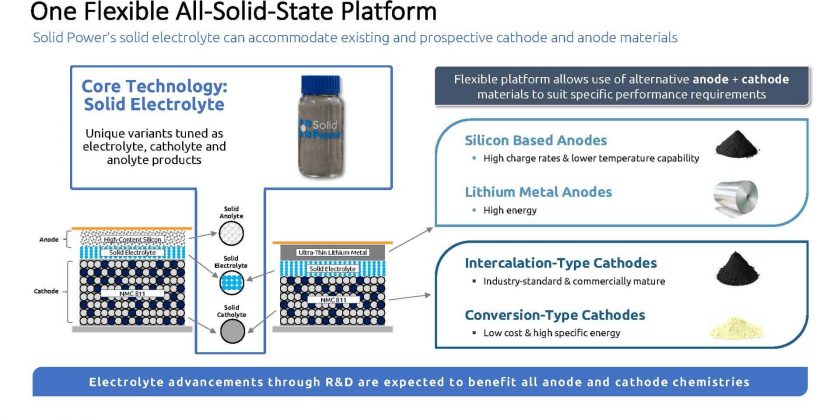This platform promises to cut cathode active material costs by 90 percent.
We have always written about Solid Power as if it was developing a solid-state battery. If we knew back then what we know now, we would have told our readers it goes beyond that. Thankfully, Solid Power allowed us to correct that today by saying what it really is about: a solid-state cell platform. You’ll understand why the difference is essential in a bit.
The All-Solid-State Platform technology developed by Solid Power does not apply only to lithium metal cells. It can also be used with current cathodes such as NMC 811. In that case, and with a solid anolyte made primarily of silicon, it can produce a cell that delivers 390 Wh/kg. For example, the Tesla 2170 has an energy density of 260 Wh/kg. Solid Power’s would be 50 percent better.
If Solid Power uses lithium metal as the anode and NMC 811 as the cathode, the energy density increases to 440 Wh/kg. That’s 69 percent better than the best cell currently available in the market, but it is also far from what Solid Power can achieve.
Its All-Solid-State Platform is also compatible with “low cost and high specific energy conversion type cathodes” that cannot be used with current “lithium-ion or other liquid-based cell architectures.”
It is here that Solid Power’s technology makes its boldest promise: with these cathodes, it could make a cell that eliminates cobalt or nickel – a metal that is now considered as the Holy Grail of high energy-dense cells. Solid Power said that this could cut 90 percent of cathode active material costs. It is a pity it does not mention which conversion type cathodes these would be.
The fact is that it must be something concrete that Solid Power is already studying. According to the company, it will allow manufacturing a battery with an energy density of 560 Wh/kg. It has more than double the energy density of Tesla’s 2170 cells. Just imagine a Model 3 with double the range or much lighter than the current one.
Solid Power made these calculations for you in the image above. A battery pack that offers a range of 266 miles, with 77 kWh – such as the one on the Model 3 – could weigh 304 kg instead of 499 kg. It could have a much lower volume – 184 liters instead of 329 l – and it would be much cheaper. All that with the high-content silicon anolyte and the same cathode. With a lithium metal anode, the battery pack would weigh 269 kg.
This is why speaking about Solid Power as a solid-state battery manufacturer is unfair. The company aims to provide better solutions for whatever chemistry you decide to use. BMW and Ford must be both proud of their investments and anxious to sell something with the All-Solid-State Platform technology. If these claims are accurate, we share the anxiety, just on the other side of the counter.
Source: Read Full Article


